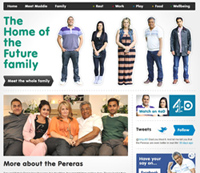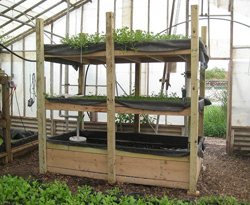As inhabitant of the Zukunftshaus (www.zukunftshaus.at) I am always curious as to what other future homes are offering. What are the new must have cutting edge features? Do these new gadgets make economic as well as ecological sense? Do they make our lives easier or more stressful? And do I want or need them in our future house?
At the recent annual Ideal Home exhibition in London, the Home of the Future featured “innovations” that are as silly as the future gets. Does it really make your life simpler if you can turn on the kettle by making a thumbs-up gesture? Is it really pleasant when a robot sends a strawberry scent to fills the room when you have received a new tweet or a lemon smell for an email? Think how your room will smell when 5 of each arrive within 10 minutes? These are the classic future flops that one comes to expect from such shows.
But what one also expects is that behind the audience-attracting weird novelties there are a few less spectacular and more sensible suggestions. Perhaps what will catch on is the egg shaped trance inducing isolation pod with a temperature-controlled waterbed and sound vibration from a subwoofer to create a massage effect (probably not). Or maybe it is the freestanding microwave with a domed design providing a 360 degree angle of what’s heating inside to avoid over-cooking and make it easier to clean than a traditional microwave (less likely). Or perhaps it will be the robotic vacuum cleaner that is aligned with a remote control attached to the shoe or slipper of the user. Two taps on a grubby spot would direct the Robo Tap to the area. Three taps returns the cleaner to its automatic programme.
[Wonderbag]
 Unless you like tap dancing, you might prefer to invest for the future in a Wonderbag (nb-wonderbag.com). This low tech very unglamorous solution to cooking has proved to be the hit of the show. Nothing more than a large brightly patterned bean bag with a hole in it, it works as follows: you first start cooking your stew or whatever on the stove then shove the whole pan into the Wonderbag where the heat is isolated and it carries on cooking for the rest of the day.
Unless you like tap dancing, you might prefer to invest for the future in a Wonderbag (nb-wonderbag.com). This low tech very unglamorous solution to cooking has proved to be the hit of the show. Nothing more than a large brightly patterned bean bag with a hole in it, it works as follows: you first start cooking your stew or whatever on the stove then shove the whole pan into the Wonderbag where the heat is isolated and it carries on cooking for the rest of the day.
Developed by a South African entrepreneur for the townships of Durban, it not only saves fuel costs, and releases no carbon, but saves lives as the fuel that many households use there release deadly toxic fumes. Unilever have been giving them away free with three boxes of curry powder, and recently ordered another 5 million bags. Even back in the UK these Wonderbags appear to be attracting much more attention and interest than any of the high-tech attention seeking gadgets currently on show. For they not only have the cache of being politically correct (tag line “eco-cooking that’s changing lives”), but are a hit with working women who can throw ingredients for a hearty meal into a pot on the stove at breakfast, and then come home to a delicious slow-cooked meal without having to hang over the stove all day. In a smart move the company have started to produce the bags in less gaudy and more trendy fabrics to fit in with modern designer kitchens.
 The surprise success of the more simple low tech solutions to living in the future was also demonstrated by the Channel 4’s Home of the Future. When the multi-generation Perera family moved back into their house remodelled for the future at a cost of some 300.000€, and with some 4 km of cable, one of the main criticisms was the overcomplicated control panels. The family all agreed they would prefer to go into a room and turn on a normal light switch.
The surprise success of the more simple low tech solutions to living in the future was also demonstrated by the Channel 4’s Home of the Future. When the multi-generation Perera family moved back into their house remodelled for the future at a cost of some 300.000€, and with some 4 km of cable, one of the main criticisms was the overcomplicated control panels. The family all agreed they would prefer to go into a room and turn on a normal light switch.
And what the family most appreciated was the fact the new layout and design improved the social interaction and communication. One of the most popular features and meeting places was a so-called Aquaponics (en.wikipedia.org). Basically a more sophisticated version of the kitchen garden, this greenhouse with pet chameleons provides a self sustainable supply of fish and veg in the back yard.
 Also making economic and ecological sense to the family were the electric cars and bikes, and fuel cell energy system. Not so popular were the suggestions from a future food expert that will in the future be eating more bugs and insects and drinking mud-coloured super-shakes (nutritional drinks made with bee pollen and raw cocoa).
Also making economic and ecological sense to the family were the electric cars and bikes, and fuel cell energy system. Not so popular were the suggestions from a future food expert that will in the future be eating more bugs and insects and drinking mud-coloured super-shakes (nutritional drinks made with bee pollen and raw cocoa).
Even the cute robot to help the mother stick to a diet was put back in its box after a few days. She got fed up of it telling her what she should and could eat. Many of the high tech features were, somewhat predictably, preaching to the converted – with the fittest member of the family being the only one to use the computerized personal fitness coach. He even put on the body-con post-work out suit that was supposed to ensure 50% less fatigue after exercising, until the family all laughed at him and he took it off. The bathroom mirror that monitors your health by reading your weight, BMI and body fat percentage was it seems for many of the family members, going to be more of a novelty than a life changing tool. And the mind-controlled relaxation tool was apparently no match for sitting on the sofa with a soap opera and a cup of tea.
My book on the Future Evolution House, “Wir Bauen ein Zukunftshaus” is available at www.amazon.de
